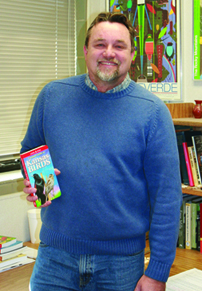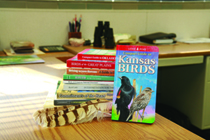Nurturing nature
K-State professor uses birding to build an appreciation for nature
When looking to take in a little nature, most would probably head for the nearest prairie or hiking trail.
 No need, according to K-State's Ted Cable. All you need to do is look out the window.
No need, according to K-State's Ted Cable. All you need to do is look out the window.
"People are surrounded by beauty; they just need to stop and take in what I call mundane miracles -- things we take for granted," Cable said. "By looking at a leaf or bird more closely they become pretty amazing things."
From his office in K-State's Throckmorton Hall, Cable says he can see a variety of birds, including catbirds and thrashers. Opportunities abound elsewhere on campus, too, he said. Campus lawns, trees and creeks, even the under-hangings of several campus buildings and other unsuspecting places can be fruitful for birdwatchers.
"Birds are conspicuous. They're elegant and colorful ... they represent what nature is all about," Cable said.
As a professor of natural resource management and a conservationist, Cable helps people interpret and appreciate nature. Introducing folks to birding is just one way to do that, he said.
To that end, his latest book, "The Compact Guide to Birds of Kansas," is a reader-friendly compilation of Kansas bird statistics and pictures of the scores of birds that can be seen right here in Kansas. The book recently took first place in the small book division of the Interpretive Media Awards Competition in Portland, Ore.
"My goal is to try to get people to see beauty in nature and to see beauty in the things around them," Cable said. "One way to do that is through birding education."
Much as a museum curator might explain a piece of abstract art to a museum patron, Cable said he helps his students and others understand the natural world and, more importantly, make an emotional connection.
 "I don't want to turn people into nature nuts, but by exposing people to the beauty of birds -- an animated, ubiquitous manifestation of nature's beauty -- and by helping them find personal meaning in nature through interpretation, I hope to get people to fall in love with birds and nature in general," Cable said.
"I don't want to turn people into nature nuts, but by exposing people to the beauty of birds -- an animated, ubiquitous manifestation of nature's beauty -- and by helping them find personal meaning in nature through interpretation, I hope to get people to fall in love with birds and nature in general," Cable said.
After all, he said, people will care for the things they care about.
"The purpose of interpreting nature for people is not to make every person we come in contact with a naturalist, but rather, to make the people we come in contact with happier people," Cable said.
More often than not, Cable said it's a matter of getting people to slow down and take in their surroundings. It's a difficult task, he said, admitting that even he has trouble getting out of his office and away from it all.
That's why he keeps a set of binoculars sitting just below his office window.
Photo: (top) Professor Ted Cable, pictured here with his latest interpretive project, has seen some 2,300 different avian species, 427 of which were in Kansas. Recently, Cable added another bird to his list: the very rare Ross’s Gull. The gull, which has never before been seen in Kansas, typically lives on the Arctic ice. Cable spotted it Jan. 14 at Tuttle Creek Reservoir. (bottom) 'The Compact Guide to Kansas Birds' stands among several of Cable's other educational works.